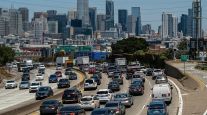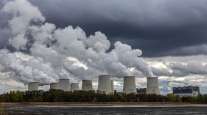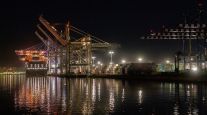Climate Changes Present Challenges For Freight Transport, Scientists Say
This story appears in the Jan. 6 print edition of Transport Topics.
Colorado transportation officials say they are considering hiring a fluvial geomorphologist — an engineer who studies changing stream flows — to help them redesign roads, bridges and culverts.
In southern New York, fuel stations within a half-mile of major highways must have backup power generators starting this year.
In each case, states are responding to extreme weather events:
• Flooding in Colorado in September damaged or washed out 50 state bridges and 200 highway miles during unprecedented rainfall.
• Superstorm Sandy in 2012 left truckers and others in New York and New Jersey without fuel because stations were without electricity for their pumps.
• Massive dust storms in Arizona figured in 40 traffic fatalities from 2000 through 2011.
Climatologists and other scientists believe such extreme weather events are the result of climate change that’s already ravaging transportation infrastructure and the nation’s ability to move freight.
They say one of the contributors to the problem is greenhouse-gas emissions. According to the Environmental Protection Agency, the transportation sector was responsible for 27% of the GHG emissions produced in the United States and its territories in 2011 — with heavy- and medium-duty trucks producing 22% of the sector’s emissions that year.
And the National Climate Assessment and Development Advisory Committee, part of the U.S. Global Change Research Program, said the effects of climate change are “reducing the reliability and capacity of the U.S. transportation system.”
A report from the committee last year said the effects include rising sea levels and storm surges, extreme weather events, higher temperatures and heat waves, precipitation changes and Arctic warming, among other climatic conditions.
Those who oversee the nation’s transportation network — overwhelmingly state and local officials — said Superstorm Sandy heightened the sense of urgency on climate change.
“Every single meeting that we have had this past year had some kind of weather-related conversation or sessions,” said Wanda Klayman, deputy executive director of the International Bridge, Tunnel and Turnpike Association.
“Here in the Northeast,” said New York State Transportation Commissioner Joan McDonald, “traditionally, we’ve been affected by snow and ice, and over the last several years we’ve had much more impact on our assets by flooding.”
“But, knock on wood, we haven’t had some of the issues that states like Colorado and Arizona have had with the wildfires,” added McDonald, who heads the climate and extreme weather committee of the American Association of State Highway and Transportation Officials.
“What we’re dealing with when it comes to these situations — fires being one of them — is the change in the environment surrounding our roadways,” said Amy Ford, communications director for the Colorado Department of Transportation.
In August, before the September flooding made headlines for the damage it caused north of Denver, a flood 70 miles south devastated a small town near Colorado Springs. U.S. 24 was damaged as heavy rainfall rushed down mountain sides denuded by the massive wildfires of the summer of 2012.
If, as some scientists believe, Colorado can expect more fires and floods, the state may have to spend millions of dollars to enlarge its culverts in order to protect roads and bridges, Ford said.
Joe Casola, staff scientist and program director for science and impacts at the Center for Climate and Energy Solutions, a think tank in Arlington, Va., said the most significant indicator of climate change is that the earth’s average temperature has risen over the last century as greenhouse gases were spewed into the atmosphere.
“We know from both basic physics and from the observations of former temperatures that those gases are making things warmer,” Casola said. “That’s the A-No. 1 piece of information that climate change is occurring.”
According to the National Oceanic and Atmospheric Administration, warmer sea levels are rising so rapidly that within 15 years, parts of Louisiana State Highway 1 will be inundated by tides about 30 times a year, on average.
Highway 1 is the access road to Port Fourchon, which handles 18% of the nation’s oil supply.
Warmer seas also turn common storms into extreme weather events, imperiling roads, bridges, ports and rail beds, Casola and other scientists said.
Maryland, with coastlines on the Chesapeake Bay and the Atlantic Ocean and 413 miles of highway in the 100-year flood plain, is one of several states conducting assessments on the vulnerability of their transportation systems to climate change.
“With climate change, a lot of the models are showing that you have a potential for more frequent 100-year storms — so, the big storm that you design for could come every 10 years or so,” said Gregory Slater, director of planning and preliminary engineering for the Maryland State Highway Administration.
Coastal states aren’t the only ones at risk from extreme flooding.
“Many inland states — for example, Vermont, Tennessee, Iowa and Missouri — have experienced severe precipitation events and flooding during the past three years, damaging roads, bridges and rail systems,” said the National Climate Assessment and Development Advisory Committee.
Vermont officials said it cost $572 million to repair the damage Hurricane Irene’s floods did to roads and bridges in 2011.
Heat also damages transportation infrastructure, and climate models project heat and heat waves will become more intense and more frequent with “severe” impacts, the National Climate Assessment stated.
“Expansion joints on bridges and highways are stressed, and asphalt pavements deteriorate more rapidly at higher temperatures,” the report said.
Likewise, wind affects transportation infrastructure and the movement of goods.
“You can have very intensive wind impacts,” said Casola, “where wind can either knock things down into roadways or across railways or you have dust storms. That happens a lot more out in desert areas in the Southwest.”
A truck driver died in Arizona in October in a 19-vehicle pileup on Interstate 10 during the kind of blinding dust storm that has scientists studying evidence the storms are caused by increasing dryness due to climate change.
Scientists in Arizona are trying to pinpoint atmospheric changes that precede dust storms so drivers can be alerted to stay off the roads.
“For dust storms, it’s so quick, just like a tornado, so the lead time is really key,” said Ave Arrellano, an atmospheric chemist at the University of Arizona.
Another truck driver died in June on Interstate 80 near Winnemucca, Nev., in the same kind of multivehicle crash during the same kind of dust storm.
The Nevada Highway Patrol said 27 vehicles were involved and that I-80 — the only route through that part of the country — was closed for 22 hours to clear the wreckage.
“Can we say definitively that climate change caused that storm in Winnemucca in June?” Nevada State Climatologist Doug Boyle asked. “It’s hard to make that leap, but we could probably say that that storm was related to the dry conditions in Nevada which are part of the drought,” he said.
Northern Nevada is in its second year of drought because of the lack of snowfall in the mountains — which, when it melts in the spring, fills the area’s reservoirs for agricultural and other uses.
“Was the drought [in 2012 and 2013] . . . because of climate change? That’s still part of the debate,” said Boyle, who also is an associate research professor in the geography department at the University of Nevada Reno.
If the Western states are growing permanently drier, Alaska is melting.
Permafrost, the ice-rich layer under the surface of the earth in Arctic regions, is disappearing, causing Alaska’s roads, rail beds and runways to crumble. State officials estimate it costs $11 million annually just to fix the roads.
For the engineers that build the nation’s highway system, climate change presents a range of challenges on everything from bridge supports to pavement.
“The problem is with pavement; we have to design it for the specific temperature and moisture range we expect it to experience,” said pavement engineer Shelley Stoffels, director of the transportation infrastructure program at the Thomas D. Larson Pennsylvania Transportation Institute at Pennsylvania State University. “If there’s a significant change in that, we’re going to get a significant change in its lifespan.”
And if climate change brings higher temperatures and heat waves, the hours construction workers can be outdoors may have to be curtailed, delaying projects, Stoffels said.
Gordon Warn, a structural engineer on the Larson faculty, said scouring is a problem with bridge supports in states experiencing increased flooding.
“The flooding in the river causes the sentiment around the bridge pier or bridge abutment to be disturbed and degraded,” Warn said. “That then makes the bridge more vulnerable for other hazards like overloading, earthquake, wind.”
Stoffels said engineers are looking for ways to mitigate the warming that is causing climate change by exploring the use of recycled materials and ways to reduce pavement’s contribution to global warming.
“These are very interdisciplinary problems, and it’s going to take a while to work them out because of that,” Stoffels said. “Most engineers and scientists are trying to consider these things and do a good job, but it’s really complicated.”




